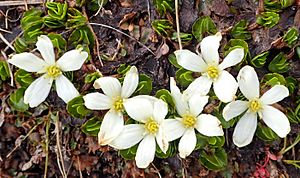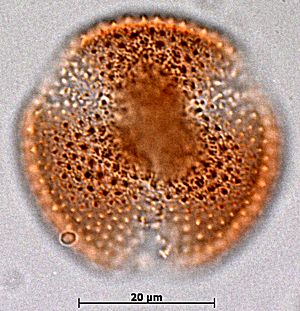White caltha facts for kids
Caltha obtusa, also known as white caltha, is a small plant that grows in the mountains of New Zealand. It's a type of perennial herb, meaning it lives for more than two years and has soft, green stems. This pretty flower belongs to the family called Ranunculaceae, which includes buttercups. You can only find the white caltha in the wild on New Zealand's South Island. It usually grows to be about 2 to 6 centimeters tall.
Quick facts for kids White caltha |
|
|---|---|
 |
|
| Scientific classification | |
| Genus: |
Caltha
|
| Species: |
obtusa
|
| Synonyms | |
|
|
Contents
What's in a Name?
The name Caltha comes from an old Greek word, kalathos. This word means "goblet" or "cup." It describes the shape of the flower, which looks a bit like a small cup. The second part of its name, obtusa, is a Latin word. It means "blunt" or "rounded."
Where White Caltha Grows
You can find the white caltha in the mountains of New Zealand's South Island. It grows in many places, especially from Canterbury southwards. This plant likes to live near water. You might see it along alpine streams or where water seeps out of the ground. It also grows around mountain lakes. Sometimes, it appears in moist, open grasslands. It can even be found in wet, gravelly areas among other small plants.
What White Caltha Looks Like
The Caltha obtusa is a small plant, usually 2 to 6 centimeters tall. It has no hairs on its stems or leaves. These plants often grow in groups, forming flat mats of leaves. Its thick, white underground stems, called rhizomes, help it store food.
Leaves and Stems
The leaves of the white caltha are shaped like a spade. They have thin stems, called petioles, which are about 8 to 12 millimeters long. These petioles have a thin, papery base that wraps around the plant. The leaf blades are dark green or yellowish-green. Sometimes, they have bronze spots or stripes. Each leaf is about 8 to 12 millimeters long and 7.5 to 11 millimeters wide. They have two small lobes at their base and a small dip at the tip. The edges of the leaves are deeply scalloped, especially near the bottom. The lobes at the base are often pressed against the top of the leaf. They are more than half as long as the main leaf and also have scalloped edges.
Flowers and Seeds
The flowers of the white caltha have five white sepals. Sepals are like small leaves that protect the flower bud. These sepals are 8 to 18 millimeters long and 6 to 12 millimeters wide. They are widest near the tip and can have a rounded or pointed end. Inside the flower, there are 10 to 15 stamens. Stamens are the parts that produce pollen. They surround the carpels, which are the parts that will become the fruit. Each carpel is about 4 to 5 millimeters long and has a long, thin style on top. People say the flowers smell like lemons!
After the flower blooms, the plant forms fruiting heads that are 12 to 18 millimeters wide. The fruits, called follicles, grow to be about 1.25 to 1.5 centimeters long. Seeds don't always ripen, which means they might not always be able to grow into new plants. White caltha flowers usually bloom between December and February. You can find its fruits from February until April.
How It's Different from Other Plants
Caltha obtusa is similar to another plant called Caltha novae-zelandiae. However, there are a few ways to tell them apart. The white caltha has white sepals that are more oval-shaped. The New Zealand marsh marigold has pale yellow sepals that are more linear. Also, the edges of the white caltha's leaves are deeply scalloped and almost lobed at the base. The New Zealand marsh marigold's leaves have only slightly scalloped or smooth edges.


